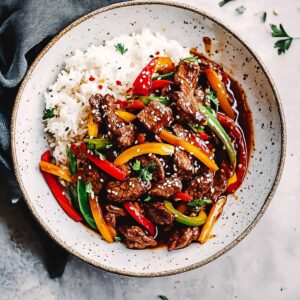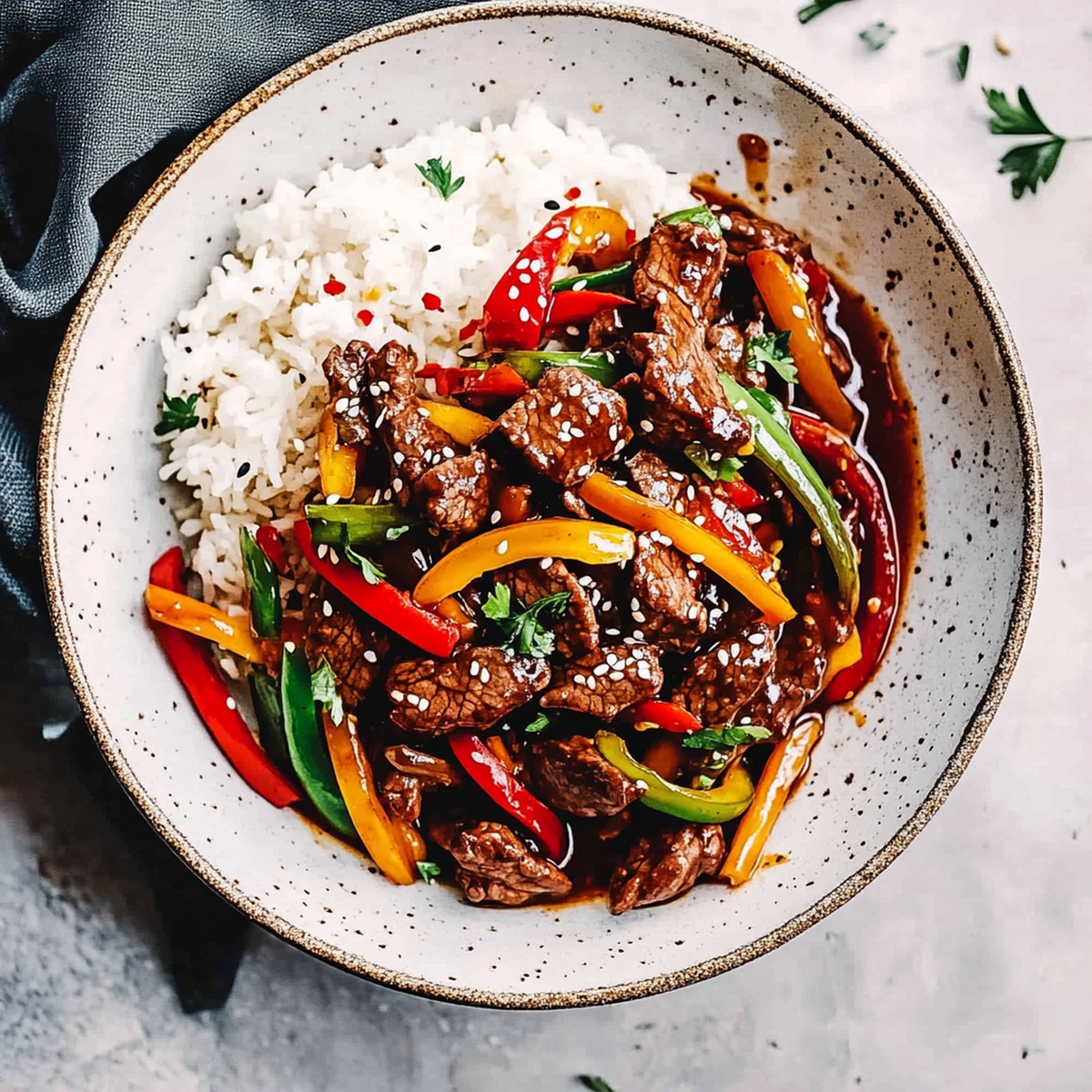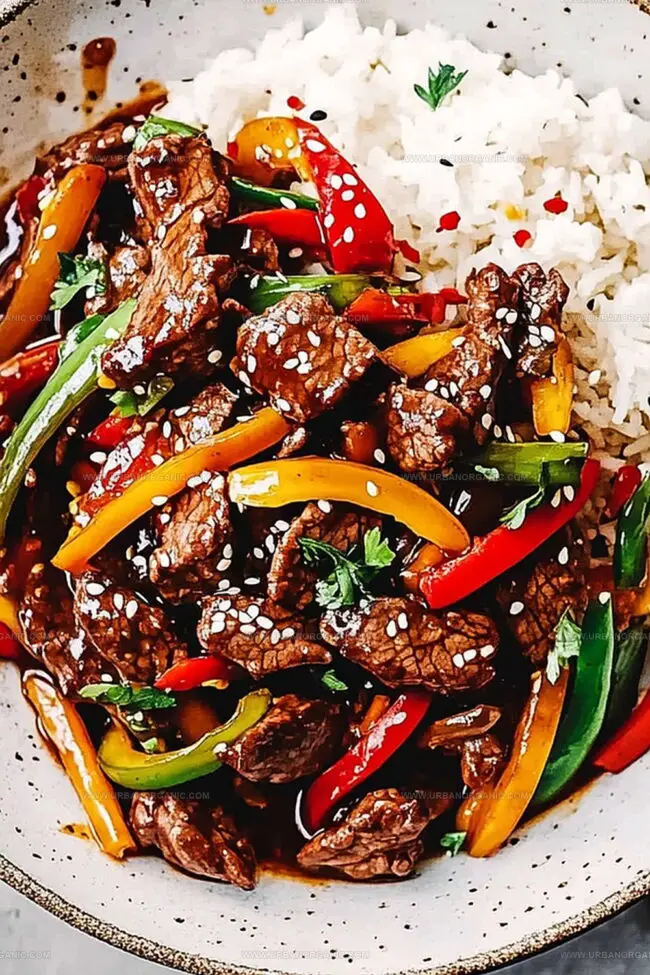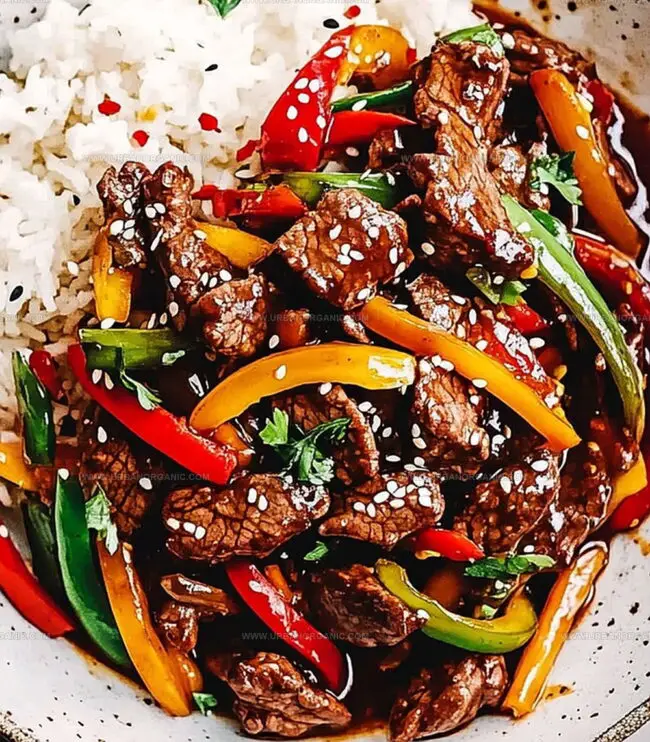Easy Beef Stir-Fry in Sticky Asian Sauce Recipe
Weeknight dinners become magical when you master this effortless beef stir fry dancing in a glossy, aromatic Asian sauce.
Busy home cooks adore quick meals that pack maximum flavor with minimal effort.
Tender meat strips sizzle alongside crisp vegetables, creating a harmonious blend of textures and tastes.
Pantry staples transform into something extraordinary with just a few smart techniques.
Each bite delivers a perfect balance of sweet, savory, and umami notes that will make you feel like a professional chef.
Colorful bell peppers and green onions add vibrant visual appeal to this simple yet sophisticated dish.
Grab your wok and let the culinary adventure begin – deliciousness awaits you!
Why Sticky Asian Beef Stir Fry Hits the Spot
What You’ll Need for Sticky Beef Stir Fry
Main Protein:Starch Coating:Sauce Ingredients:Stir Fry Instructions for Bold Flavor
Step 1: Prepare Succulent Beef
In a large mixing bowl, coat beef slices thoroughly with cornstarch, ensuring each piece is evenly dusted. The cornstarch creates a delightful crispy exterior and helps thicken the sauce during cooking.
Step 2: Create Flavor-Packed Sauce
Whisk together soy sauce, honey, rice vinegar, minced garlic, grated ginger, and a splash of sesame oil in a separate bowl. This combination builds a complex, mouth-watering sauce that will make your taste buds dance.
Step 3: Heat Up the Wok
Warm a large wok or skillet over high heat. Add a thin layer of cooking oil, allowing it to become shimmering hot but not smoking.
Step 4: Sear the Beef
Carefully place beef slices into the hot wok, ensuring they are not overcrowded. Cook for 2-3 minutes, tossing quickly to achieve a beautiful golden-brown sear on all sides.
Step 5: Incorporate Crunchy Vegetables
Toss in colorful bell peppers, sliced onions, and broccoli florets. Stir-fry for an additional 2-3 minutes until vegetables are crisp-tender.
Step 6: Pour and Simmer Sauce
Pour the prepared sauce over the beef and vegetables. Allow the mixture to simmer and bubble, coating everything in a glossy, tantalizing glaze.
Step 7: Final Touches
Sprinkle with sesame seeds and chopped green onions. Serve immediately over steamed rice or noodles for a restaurant-quality meal at home.
Tips for Sauce That Clings Just Right
Store and Reheat Beef Stir Fry Smartly
What to Serve with Asian Beef Stir Fry
Variations to Add Some Heat or Crunch
Sticky Beef Stir Fry FAQs
Cornstarch creates a protective layer that helps seal in moisture, prevents the beef from overcooking, and gives a crispy exterior when stir-fried. It also acts as a natural thickener for the sauce, making it more glossy and rich.
Yes, you can substitute beef with chicken, pork, or shrimp. Just ensure you slice the meat thinly and adjust cooking time accordingly to prevent overcooking.
A wok or a large, heavy-bottomed skillet works best. These pans distribute heat evenly and provide enough surface area to cook the meat and vegetables quickly at high temperatures without steaming them.
Cook the beef on high heat for a short time, keeping it moving in the pan. Slice the meat against the grain and avoid overcrowding the pan, which helps maintain tenderness and allows proper browning.
Print
Easy Beef Stir Fry In A Sticky Asian Sauce Recipe
- Total Time: 25 minutes
- Yield: 4 1x
Description
Quick and flavorful Beef Stir Fry dances with bold Asian-inspired seasonings, delivering restaurant-quality magic in minutes. Sizzling tender beef strips and crisp vegetables combine perfectly, giving home cooks a delicious meal that satisfies all cravings.
Ingredients
Proteins:
- 1 pound (450 grams) flank steak or sirloin, thinly sliced against the grain
Vegetables:
- 1 red bell pepper, sliced
- 1 cup broccoli florets
- 1 carrot, thinly sliced
- 2 cloves garlic, minced
- 1 tablespoon fresh ginger, grated
- 2 green onions, sliced
Sauce and Seasoning:
- ¼ cup (60 milliliters) soy sauce
- 2 tablespoons hoisin sauce
- 2 tablespoons honey
- 1 tablespoon rice vinegar
- 1 teaspoon sesame oil
- ½ teaspoon chili flakes
- ¼ cup (60 milliliters) water
- 2 tablespoons cornstarch
- 2 tablespoons vegetable oil
- Sesame seeds (optional)
Instructions
- Thoroughly coat beef slices with cornstarch, ensuring an even layer that will create a delicate crispy exterior and contribute to sauce thickening during cooking.
- Heat a large wok or skillet over high flame, allowing the surface to become extremely hot before adding oil to prevent sticking.
- Quickly sear beef pieces in batches, avoiding overcrowding the pan, which allows each slice to develop a golden-brown caramelized crust without steaming.
- Remove browned beef and set aside, keeping the meat warm while preparing the aromatic vegetable base.
- In the same pan, sauté minced garlic and ginger until fragrant, releasing their intense, sharp flavors without burning.
- Add sliced bell peppers, carrots, and green onions, stirring rapidly to maintain their crisp texture and vibrant colors.
- Whisk together soy sauce, rice vinegar, honey, and sesame oil to create a glossy, complex sauce that balances sweet, tangy, and umami notes.
- Return beef to the pan, pour the prepared sauce over the ingredients, and toss quickly to ensure every morsel is evenly coated and heated through.
- Garnish with toasted sesame seeds and additional sliced green onions for a final burst of freshness and textural contrast.
- Serve immediately over steamed jasmine rice, allowing the sauce to slightly soak into the grains for maximum flavor absorption.
Notes
- Ensure beef is sliced against the grain for maximum tenderness and easier chewing.
- Use a high-heat cooking method like a wok or cast-iron skillet to achieve that perfect golden-brown sear on the meat.
- Add extra vegetables like bell peppers or snap peas to boost nutrition and create more texture variation in the dish.
- For a gluten-free version, swap regular soy sauce with tamari and use certified gluten-free cornstarch.
- Prep Time: 10 minutes
- Cook Time: 15 minutes
- Category: Dinner, Lunch, Snacks
- Method: Sautéing
- Cuisine: Asian
Nutrition
- Serving Size: 4
- Calories: 350
- Sugar: 10 g
- Sodium: 800 mg
- Fat: 20 g
- Saturated Fat: 3 g
- Unsaturated Fat: 15 g
- Trans Fat: 0 g
- Carbohydrates: 25 g
- Fiber: 2 g
- Protein: 24 g
- Cholesterol: 70 mg




Jessica Martinez
Pastry Chef & Recipe Developer
Expertise
Organic Baking Techniques, Gluten-Free Recipe Development, Southwestern Dessert Specialties, Food Styling and Photography
Education
Santa Fe Community College (SFCC)
Jessica brings the sweet side to Urban Organic with her passion for baking and love for the Southwest. She trained at Santa Fe Community College and has built a career creating beautiful, gluten-free, and organic desserts that feel both nostalgic and new.
She believes baking should be fun, creative, and open to everyone, no matter your diet or skill level. Jessica’s recipes are simple enough to follow, but special enough to remember.